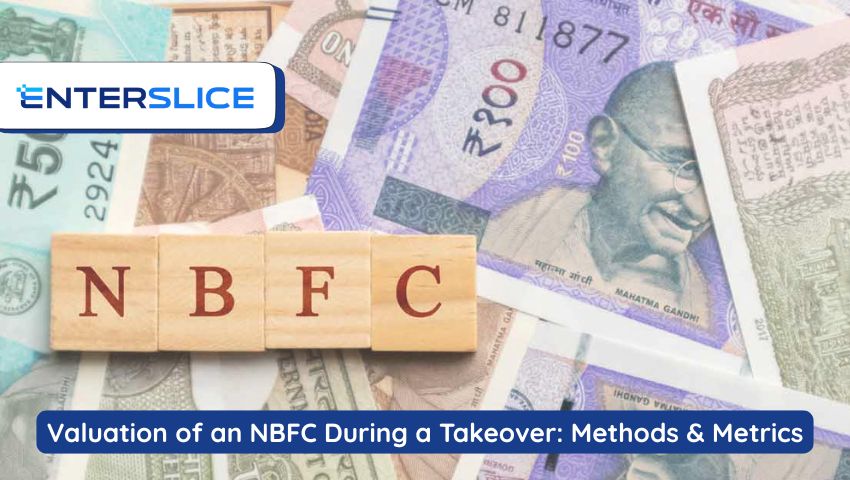The financial sector has witnessed a growing number of mergers and acquisitions, particularly involving Non-Banking Financial Companies (NBFCs). These institutions have become attractive targets for larger financial entities and private equity players seeking growth, diversification, or a strategic foothold in specific market segments.
However, executing a takeover of an NBFC involves far more than due diligence and regulatory approval. A key component of any NBFC takeover is valuation – a complex process that takes into account multiple factors, both quantitative and qualitative.
In this guide, we will explore how the valuation of an NBFC is conducted during a takeover, what methods are used, and the critical metrics that buyers and analysts focus on.
Understanding NBFCs and the Importance of Valuation
NBFCs play a crucial role in India’s financial ecosystem by offering loans, asset financing, leasing, and investment products, often serving markets that traditional banks underserve. Because they are regulated by the Reserve Bank of India (RBI) but operate with more flexibility than banks, NBFCs have become an integral part of the credit delivery mechanism.
When a takeover of NBFC is on the table, valuation becomes essential for the acquiring company to:
-
Determine a fair purchase price
-
Understand the target’s financial health and growth potential
-
Assess risk exposure, including asset quality and regulatory liabilities
-
Justify the acquisition to stakeholders and regulators
The valuation must be accurate, defendable, and aligned with current market conditions and industry benchmarks.
Factors That Influence NBFC Valuation
Before diving into valuation methods, it’s important to understand the core factors that influence the valuation of an NBFC:
-
Loan Book Quality: The health of the loan portfolio is paramount. High levels of non-performing assets (NPAs) reduce valuation, while a well-performing loan book boosts it.
-
Capital Adequacy Ratio (CAR): A strong CAR reflects an NBFC’s ability to absorb losses, influencing its stability and value.
-
Net Interest Margin (NIM): This indicates profitability derived from lending activities. Higher NIMs suggest stronger earning potential.
-
Asset-Liability Management (ALM): An NBFC with balanced ALM is considered financially healthier, which supports higher valuations.
-
Compliance and Regulatory Standing: Companies with clean records and compliance with RBI guidelines are valued higher due to lower regulatory risks.
-
Customer Base and Market Position: Niche positioning, brand recognition, and customer loyalty can add intangible value to the NBFC.
-
Management and Operational Efficiency: Quality of leadership, internal controls, and technological integration impact investor confidence.
Each of these factors is weighed differently depending on the valuation method chosen.
Valuation Methods for NBFC Takeovers
There is no one-size-fits-all approach to NBFC valuation. Different methods are used depending on the size, structure, and business model of the NBFC. Here are the most commonly applied methods in an NBFC takeover:
1. Net Asset Value (NAV) Method
The NAV method values the NBFC based on the net worth of its assets minus liabilities. This includes revaluation of financial assets, such as loans and investments, at fair market value.
This method is particularly useful for asset-heavy NBFCs, especially when there’s limited profitability or inconsistent earnings.
Formula:
NAV = Total Assets (at Fair Value) – Total Liabilities
However, this method may not reflect future earning potential, so it’s often used in combination with other approaches.
2. Discounted Cash Flow (DCF) Method
The DCF method projects the future free cash flows of the NBFC and discounts them back to present value using a suitable discount rate (often the weighted average cost of capital or WACC).
This method works best when the NBFC has a predictable and stable cash flow history.
It involves forecasting:
-
Loan disbursements and repayments
-
Interest income and expenses
-
Operating costs
-
Tax impacts
-
Capital expenditures and working capital needs
The DCF approach can be very insightful but is sensitive to assumptions, making it more complex and subjective.
3. Comparable Companies Method (Market Multiples)
This method involves benchmarking the target NBFC against other similar listed or recently acquired NBFCs using key financial ratios such as:
-
Price-to-Earnings (P/E) ratio
-
Price-to-Book (P/B) ratio
-
EV/EBITDA (Enterprise Value to Earnings Before Interest, Taxes, Depreciation, and Amortization)
This approach is widely used in practice because it reflects market sentiment. However, it relies heavily on the availability of comparable transactions and may not capture the specific nuances of the target NBFC.
4. Precedent Transaction Analysis
This method looks at historical NBFC takeover deals and derives valuation multiples from those transactions. It provides insight into how the market values similar acquisitions under comparable circumstances.
It is especially useful in determining a premium price, which acquirers often pay to secure control of a company.
Also Read: Documents Needed for Alternative Investment Fund Registration
Key Metrics in NBFC Valuation
Regardless of the valuation method, several key metrics are commonly used in an NBFC takeover:
-
Net Worth: Indicates the book value of the company after accounting for all liabilities.
-
Gross and Net NPA Ratios: Measure the asset quality and potential loss exposure.
-
Return on Assets (ROA) and Return on Equity (ROE): Assess operational efficiency and profitability.
-
Capital Adequacy Ratio (CAR): A regulatory benchmark that reflects financial stability.
-
Cost-to-Income Ratio: Measures operational efficiency by comparing costs to income.
-
Loan-to-Deposit Ratio: Indicates liquidity and lending aggressiveness.
Buyers analyze these metrics in the context of the industry average and historical performance of the target NBFC.
Premium and Discount Considerations
In an NBFC takeover, the final valuation is rarely just a mathematical result. Strategic factors often lead buyers to offer a premium or negotiate a discount.
Premiums may be offered due to:
-
Access to new markets or customer segments
-
Strength of the NBFC’s brand or distribution network
-
Operational synergies
-
Faster regulatory entry through acquisition
Discounts may apply in cases of:
-
High NPAs
-
Pending legal issues or compliance concerns
-
Poor financial records
-
Weak management or governance
A comprehensive valuation will factor in these strategic considerations during final negotiations.
Regulatory Approvals in NBFC Takeovers
The valuation is just one part of the takeover. Acquirers must obtain prior approval from the Reserve Bank of India (RBI) for significant ownership changes in NBFCs.
Key regulatory requirements include:
-
Fit and proper criteria for new shareholders and directors
-
Disclosure of the source of funds used in the acquisition
-
Compliance with KYC and anti-money laundering guidelines
RBI often scrutinizes not only the transaction structure but also the valuation rationale to ensure transparency and fairness.
Also Read: Eligibility Criteria for NBFC Registration Online
Conclusion
Valuing an NBFC during a takeover is a complex but critical step in ensuring a successful acquisition. Whether you are a strategic investor, financial institution, or private equity firm, understanding the valuation methods and metrics is essential to assess both risks and opportunities.
A thoughtful combination of NAV, DCF, market multiples, and transaction precedents-alongside a detailed analysis of loan books, capital adequacy, and earnings potential-will provide a clearer picture of the NBFC’s worth.
Given the regulatory sensitivities and financial complexities involved in an NBFC takeover, it is advisable to work with experienced valuation professionals and legal advisors to conduct a robust, defensible, and compliant valuation process.
FAQs
1. Is RBI approval required for all NBFC takeovers?
Yes, the Reserve Bank of India requires prior approval for any acquisition or transfer of control in an NBFC, whether through share transfer or change in management.
2. How is an NBFC with high NPAs valued during a takeover?
NBFCs with high non-performing assets are usually valued at a discount due to their impaired asset quality. Detailed due diligence is conducted to assess real recovery potential.
3. Can a startup NBFC with limited earnings be acquired?
Yes, even early-stage NBFCs can be targets, especially if they have unique licenses, tech-driven models, or strategic positioning. Valuation in such cases often relies on asset value and future projections.
 :
https://in.pinterest.com/parulschaudhary/
:
https://in.pinterest.com/parulschaudhary/

